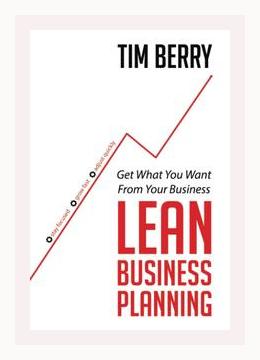Entrepreneurship and StartupsBusiness Planning
**
Introduction
Tim Berry’s “Lean Business Planning” revolutionizes the traditional approach to business planning, emphasizing simplicity, flexibility, and continuous revision. The central theme is to think of a business plan as a living document that evolves over time, rather than a static, exhaustive report. Lean business planning is for entrepreneurs, small business owners, and startups looking for a pragmatic and adaptable method to navigate the complexities of business strategy.
1. Core Principles of Lean Business Planning
Lean business planning revolves around four core principles: simplicity, accountability, regular review and revision, and focusing on what matters. Berry argues against the cumbersome, detailed business plans of old and advocates for concise, actionable plans that fit on a single page or a few slides.
Action: Simplify Your Plan
Immediate steps include creating a Lean Plan that consists of a bullet-point outline covering strategy, tactics, concrete specifics, and essential projections.
Example:
Instead of a 50-page document, create a one-page plan specifying the business identity, target market, value proposition, key performance indicators (KPIs), tactics, and essential milestones.
2. Recognize and Adapt Your Strategy
Berry emphasizes that strategy is about focus. Clear strategic thinking involves understanding the business identity (who you are) and the market opportunity (what you offer and to whom).
Action: Perform a SWOT Analysis
List your company’s strengths, weaknesses, opportunities, and threats to align your strategic focus.
Example:
A bakery might identify local sourcing as a strength and increasing demand for gluten-free options as an opportunity, guiding them to emphasize locally-sourced, gluten-free products.
3. Tactical Implementation
Tactics are the actionable steps required to execute the strategy. They involve specific activities and processes to reach business goals.
Action: Develop Tactical Plans
Create detailed action points linked directly to the strategy, such as marketing campaigns, sales processes, product development timelines, and customer service standards.
Example:
If the strategy focuses on digital engagement, a tactic might be to run targeted social media campaigns, utilize SEO, and foster an online community.
4. Detailed Specifics and Milestones
Every Lean Plan should spell out key specifics to track, including responsibilities, deadlines, and milestones. Berry insists that concrete specifics enable accountability and follow-through.
Action: Assign Responsibilities and Set Deadlines
Distinguish who is responsible for what and establish clear timelines for achieving specific tasks and milestones.
Example:
Assign one team member to oversee the social media campaign launch by the end of Q1, ensuring milestones such as content creation, scheduling, and metrics tracking are met.
5. Metrics and Accountability
Consistently track key metrics and performance indicators. Measurement allows for timely adjustments and insights into what’s working or what needs modification.
Action: Establish KPIs
Determine relevant KPIs such as customer acquisition cost, conversion rates, sales growth, or customer satisfaction scores, and regularly track these metrics.
Example:
A subscription box service could track monthly new subscriptions, churn rates, and average revenue per user (ARPU) to gauge performance.
6. Financial Projections
Lean business planning includes basic financial forecasting, focusing on realistic, simple financial projections like sales forecasts, expense budgets, cash flow, and profit/loss estimation.
Action: Create Financial Projections
Produce straightforward, realistic financial projections and update them regularly based on actual performance and market conditions.
Example:
An e-commerce startup might project monthly sales figures, operating costs, and net profit targets, revising these projections as real sales data is gathered.
7. Regular Review and Revision
Berry underlines the necessity of regular plan reviews, suggesting monthly refreshes to align with actual business performance and external changes.
Action: Schedule Monthly Plan Reviews
Implement monthly meetings to review the plan, assess performance, and make necessary adjustments.
Example:
A small marketing firm could hold monthly strategy sessions to review client acquisition metrics, campaign effectiveness, and adjust tactics and resource allocation accordingly.
8. Continuous Improvement Cycle
Lean business planning fosters a culture of continuous improvement. Instead of static plans, it encourages iterative cycles of planning, reviewing, and revising.
Action: Adopt a Plan-Do-Check-Act Approach
Utilize a continuous improvement cycle where plans are implemented, results are reviewed, and necessary changes are made.
Example:
A SaaS company could introduce a new feature based on user feedback, monitor user engagement post-launch, and tweak the feature based on data collected.
9. Communication and Collaboration
The Lean Plan is a communication tool, aiding clarity and collaboration among team members. It ensures everyone is aligned with the business goals and activities.
Action: Share and Discuss the Plan
Ensure that the Lean Plan is accessible to all relevant stakeholders and encourage regular discussions about progress and challenges.
Example:
A retail store chain could use their Lean Plan in team meetings to communicate upcoming marketing initiatives and sales targets, fostering a collaborative effort.
10. Avoiding Common Pitfalls
Berry discusses pitfalls such as overcomplicating plans, relying on long-term static plans, and overlooking the importance of flexibility and adaptability.
Action: Focus on Agility and Simplicity
Embrace changes and do not let the pursuit of perfection hinder practical implementation and adaptability.
Example:
Instead of sticking rigidly to a five-year plan, a tech startup should remain agile—pivoting based on market feedback and technological advancements.
Conclusion
Tim Berry’s “Lean Business Planning” serves as an essential guide for modern entrepreneurs and business owners, emphasizing adaptability, simplicity, and continuous improvement. The actionable strategies provided facilitate realistic and effective business planning in rapidly changing environments.
In summary, to implement Lean Business Planning:
1. Simplify Your Plan: Start with a succinct one-page plan.
2. Regular Review: Schedule monthly reviews to keep the plan current.
3. Detailed Tactics: Specify actionable, strategic tasks.
4. Assign Accountability: Clearly assign responsibilities and deadlines.
5. Track Metrics: Continuously monitor relevant KPIs.
6. Realistic Financials: Create and revise financial projections.
7. Foster Collaboration: Use the lean plan for clear communication among team members.
8. Embrace Flexibility: Stay adaptable and ready to pivot based on real-world insights.
By following the outlined principles and actions, businesses can navigate towards sustained growth with a focused and pragmatic approach.
